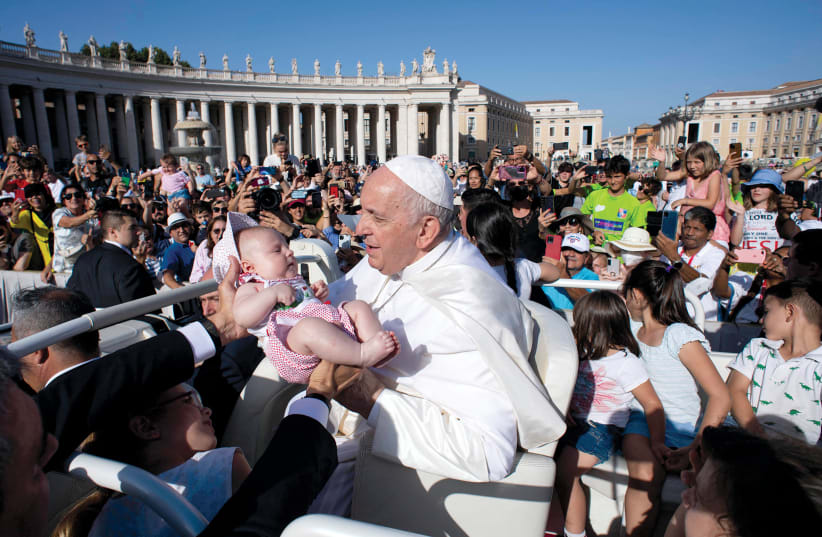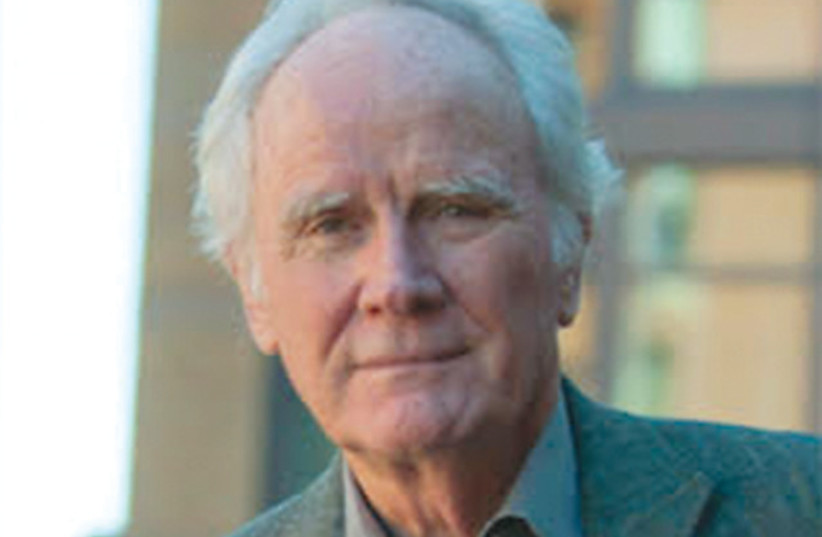In the wake of the leaks about the US Supreme Court’s possible reversal of Roe v. Wade, the issue of abortion and women’s reproductive rights is very much in the news again. And the stance of the Catholic Church regarding abortion has once again become central to this discussion.
But the attitude of the Church to women, abortion and to sex in general is not new. It is very much a part of its long history
This and many other issues were discussed on a Zoom seminar that I attended a few weeks ago with the well-known American liberal Catholic author James Carroll, which took place at Boston College under the auspices of their Center for Christian-Jewish Learning.
Led by Professor Rabbi Ruth Langer, the seminar marked the 20th anniversary of the publication of Carroll’s bestselling book, Constantine’s Sword: The Church and the Jews. The discussion was based on questions raised by students at BC who had clearly read the book thoroughly. Carroll gave thoughtful answers to all their questions in his usual profound and poignant manner, with creased eyebrows and piercing eye contact with the students.
I read Constantine’s Sword when it was published (all 700 pages of it!) and it left a strong impression on me. I would say that it was one of those books that changed the course of my life, certainly my professional life as an interreligious educator and activist. Here was a brilliant Catholic thinker and writer who did enormous research into the history of Christian anti-Judaism and antisemitism, which was absolutely amazing in its forthrightness and candor. It opened my eyes to a new world of Christian authors, scholars and interreligious activists who were confronting their past in serious and substantive ways.
After this Zoom seminar, I was motivated to look online to see what Carroll has written lately. I discovered that he published a memoir last year entitled The Truth at the Heart of the Lie. I immediately ordered it and read it on Kindle. As with many of Carroll’s previous books that I have read, this one was also personal, passionate and profound. It was also soul-wrenching in its honesty and deeply disturbing in so many ways, more so than all of his books combined.
The starting point for Carroll is the crisis in the Catholic Church concerning sex abuse by Catholic priests over many decades and in many countries, especially in the USA and Ireland. This major moral crisis – and the failure of the Church to act effectively to end it once and for all, including the inaction by Pope Francis – is the catalyst for Carroll’s personal reflections at this time. In his in-depth and well-researched writing, he reveals fundamental problems in the Church’s theology and practice, which in his view desperately need to be corrected if the Church is to remain relevant in the 21st century.
Three stories woven together
Carroll weaves together three stories: the first is what he calls “the saga of history, of how the Catholic Church, from the days of the Roman Empire through the feudal Middle Ages, reinterpreted Scripture and the meaning of Jesus to become a bastion of male supremacy and theological doom, one empowering a clerical elite – priests – who became, for the believers, the self-serving gatekeepers of eternity.” Throughout the book, he argues compellingly that “clericalism is both the root cause and the corrupter, the ongoing enabler of the present Catholic catastrophe... by now it is clear that the entire milieu with which priests live and exercise ministry – its theology, aesthetic, lifestyle, heritage, values and structure of authority – is the issue.”
Since Constantine’s Sword and other books, Carroll has become a historian of the Church in great detail, as well as a contemporary critic from within, with no-holds-barred.
The second story interwoven throughout this book is the one that has shaken the world in recent decades: the reports of massive sexual abuse by Catholic priests against children in many countries of the world. Not only have priests abused children in large numbers, but many bishops, and even archbishops, have protected the predators (their colleagues, the priests) instead of the children who were their victims. In addition, the news of the scandal of sex abuse by priests in Ireland in 2018 was particularly shocking for Carroll, especially since he felt that Pope Francis came to Ireland and gave lip service to doing something about it, but didn’t actually do much to change the culture that allows this to continue when he returned to the Vatican.
The third story that we find throughout this book, as in many of his previous books, is his own story. Carroll is very much a memoirist, as well as a historian. His books are always profoundly personal, but this one takes the prize. Here he shares his life story in painful yet poignant ways:
This story is my own – how Jimmy, how I, became a priest; then a writer, and an op-ed columnist for The Boston Globe, even as that paper’s Spotlight team broke the Church’s sexual abuse scandal; and finally, a shattered believer forced to confront the corruption at the heart of my faith.
I found it fascinating to learn why and how he entered the priesthood through the Paulist Fathers, how he served as a priest at Boston University during the years of the anti-war struggle against the immoral war in Vietnam, and ultimately why and how he left the priesthood, especially how it was related to the issue of women in the church.
In addition, one of the amazing things about this book, especially toward the end, is that despite his crisis of faith and his facing the horrific news about the child abuse scandals and its cover-up by the Church in so many places, Carroll does not give up on the Catholic Church! On the contrary, he describes this book as “a journey from broken faith to chosen hope.”
In fact, since Constantine’s Sword 20 years ago, when he called for “Vatican III,” (i.e., another Vatican Council like the one in the 1960s called “Vatican II,” which brought the church into the 20th century), he has been demanding, pleading and cajoling the Catholic Church to undergo many radical reforms once again, in order to make it relevant to the times in which we live. He was hoping that Pope Francis might be the pope to do this, but apparently, he is facing constant conservative opposition and is not able to go as far as Carroll would like.
Nevertheless, Carroll chooses hope over despair. The last three chapters of the book are entitled “Chosen Hope.” In these chapters he points out that “the Catholic Church is the largest nongovernmental organization on the planet, with countless men and women caring for the poor, teaching the unlettered, healing the sick, and working to preserve minimal standards of the common good.”
Thus the Catholic Church is not going away, since it is very much needed in our world. But it will have to change:
The world needs this global institution to be rational, historically minded, pluralistically respectful, committed to peace, a tribune of justice, and a champion of the equality of women. That Vatican II occurred at all is enough to validate, if not belief in the Holy Spirit, the hope that this great institution can survive the contemporary moral collapse of its leadership.
While he lauds the leadership of Pope Francis on many key issues, including religious pluralism, the future of the planet, and the fate of the dispossessed, Carroll remains deeply distressed that he has not taken on the issue of sexual abuse, and the attitude of the church to women, in a more forthright and consistent fashion.
For Carroll, hope is a choice, and it is what he chooses. He is very much a dreamer, but he tries also to keep his feet on the ground:
At the most practical level, a reformed, enlightened, hopeful Catholic Church is essential to the thriving – even to the survival – of the human species. The climate crisis makes the point, but so does the increasing threat of nuclear proliferation. And then, almost equally pressing, there is the plague of global inequality.
Can the Catholic Church be reformed? Can the culture of clericalism change? Can the leadership of this worldwide church confront and correct the sex abuse scandals that have caused it to lose so much of its moral authority? Can the approach to women within the Church change, and can women be ordained as priests? Can the Church’s attitude to abortion be updated to the 21st century?
I don’t know the answer to any of these questions, but I am convinced by Carroll’s book that radical reform is necessary. I am also impressed by his persistence, his refusal to give up, his insistence on keeping hope alive.
In my part of the world – Israel/Palestine – keeping hope alive is essential for our human condition and for our collective future. I appreciate anyone who endeavors consistently to do so, despite enormous obstacles and challenges. ■
Rabbi Dr. Ron Kronish is the founding director the Interreligious Coordinating Council in Israel (ICCI), which he directed for 25 years. Now retired, he is an independent educator, author, lecturer, writer, speaker, blogger and consultant. The editor of five books, including Coexistence and Reconciliation in Israel-Voices for Interreligious Dialogue, he is currently working on a new book about Israeli and Palestinian peace builders.

